The best fighter in the world
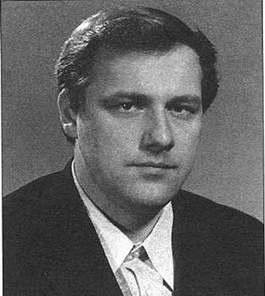
The experience of fighting in Vietnam showed that the use of fighter planes with limited maneuverability F-4 "Phantom", armed only with the Sparrow and Sidewinder missiles, proved to be untenable. Even the outdated MiG-17, with vigorous maneuvering, had time to evade missiles, entered the "Phantoms" at the tail and shot them with powerful cannon weapons. It was not by chance that the US Air Force was forced to urgently equip the F-4 with an M-61 "Vulcan" cannon of the 20 mm caliber of high rate of fire.
It was the experience of the Vietnam War that pushed the US to develop the concept of a new fighter aircraft with enhanced maneuverability, armed with guided missiles and cannons, and equipped with new weapons control systems (increased range and resolution, multi-channel). The US Air Force announced a competition for the development of the YF-15 aircraft, in which four firms participated. This is what we now call fourth generation fighter jets.
A similar competition was announced by our Air Force. It was attended by MiG, Su and Yak firms. At first, P. Sukhoi wanted to refuse to participate in the competition, explaining that our lag in radio electronics would not allow us to create a relatively light aircraft. In addition, the requirements for a promising front-line fighter (PFI) included the following: op should be the same for the Air Force and aviation Air defense of the country. This was practically impossible at all, if only because the Air Force radars operated in the 2-cm range, and the air defense aviation radars - in the 4-cm range.
P. Sukhoi’s perseverance lasted for several months until he was “twisted arms”, and he gave the command to start work. Honestly, we did not start from scratch: for more than a year, such development was carried out in the project department, although only one designer worked on it - Vladimir Ivanovich Antonov. I could not single out anymore, although I was sure that we would have to do this.
The basis of the aerodynamic layout of the wing was based on the concept of the so-called "sinusoidal wing". At the beginning of I960, in the English magazine Aerocraft Engineering, the results of blowing such a wing in wind tunnels were presented, moreover, with visualization of its flow, which showed that a sinusoidal wing with a sharp edge gives rise to an almost end section. The French obtained similar results on the so-called "Gothic" wing.
Thus, by the time when, at the beginning of 1971, Mr. P. O. had instructed to proceed with the development, we were already partly ready. Over the weekend (so that no one interfered) three people came to work: Vladimir Antonov, Valery Nikolayenko and me. Thus, the first layout of the T-10 aircraft, the future Su-27, came into being. At the same time, under the influence of the T-4MS aircraft, the entire surface of the new machine was carried out by a set of deformed aerodynamic profiles, and then the head part of the fuselage was built on it and the engine nacelles were suspended. This layout is called "integral". In addition, on the basis of the flight tests of the T-4 aircraft, it was decided to carry out the aircraft statically unstable at subsonic flight speeds with an electric four-time redundant control system.
- Antonov and Nikolayenko carried out the necessary calculations and worked through the most responsible nodes, and I plotted the layout. Not everything turned out right away. In particular, the scheme with a three-bearing chassis did not fit in any way. Therefore, on this, the first layout of the chassis was performed on a bicycle scheme with the distribution of loads as with a three-support scheme. Underwing supports were retractable in the fairings on the wing.
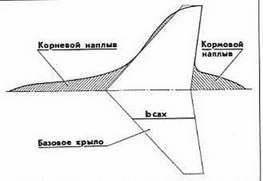
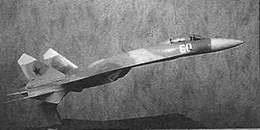
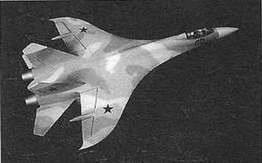
P. O. was reported on Monday. He carefully reviewed the layout and ordered a purge model for the TsAGI T-106 pipe to be made. The results of the blowdowns were very encouraging - with a moderate elongation equal to 3,2, we obtained the value of the maximum aerodynamic quality 12,6.
Despite the fact that the work on the new car was in full swing, did not leave doubts - what if we missed some other more advantageous option? In the process of designing, we had sufficiently detailed information from the open foreign press about layout schemes developed in the USA under the program YF-15. Frankly, I liked the layout of Northrop, which was similar to ours, and I was afraid that this particular project would win the competition. And when it was announced that the Mac Donnell firm won the contest, I sighed with relief. It should be noted that by that time we had developed a layout like MD F-15 and carried out purging the model in TsAGI. Therefore, I gained confidence that the F-15 will never catch up with the Su-27 in its flight characteristics. It was not excluded, however, that in the open press we were misled by misinformation. When at the beginning of 1972 the F-15 aircraft was shown to journalists and its photos and general views appeared, I completely calmed down. By the way, at that time, TsAGI's chief Georgy Petrovich Svishchsv came to P. Sukhoi and, entering the office, said the significant words: “Pavel Osipovich! Our backlog has become our advantage. The plane took off, and we know what it is. ”
If we talk about the company Mac Donnell, it seems to me that when creating the F-15 it was influenced by the layout of the MiG-25 aircraft.
Since the development of the preliminary project required an expansion of the scope of work, I secured PO's consent to transfer all cases of the Su-27 aircraft to the L. Bondarenko brigade - it was the least loaded at that time.
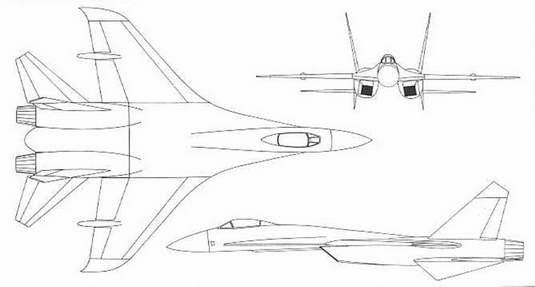
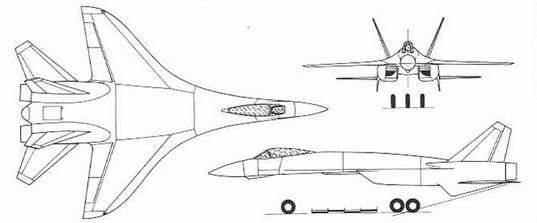
General views and purge models of the classical (above) and integral (below) schemes presented in the preliminary design of the Su-27 aircraft
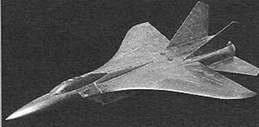
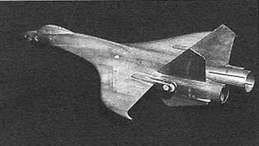
Our project was thought of in six books, but we managed to develop only two. They presented general views and basic data of two variants of layout schemes: integral and classical, with a conventional fuselage. The main thing that has been given attention in this book. - This is the calculation of the take-off weight gradients of the aircraft (I personally conducted them). Thus, it was found that an increase in the weight of the purchased finished product of onboard electronic equipment by 1 kg increases the take-off weight of the aircraft by 9 kg. For the dry weight of the engine, this gradient was equal to 4 kg, for mechanical equipment - 3 kg.
Began a deeper study of the draft aircraft. First of all, under the pressure of technologists, we were forced to move away from the ideology of a single bearing body, assembled from wing profiles, and organize, where possible, especially in loaded zones, lined surfaces. Designed the pillars of the main landing gear by the type of the US F-14 "Tomcat". In this case, the stand got out of the hull and fit into special fairings, which increased the cross-sectional area of the aircraft. And here I made a big mistake - the doors of the chassis niches were made in the form of brake flaps (as on the Su-24) that opened across the stream before the horizontal tail, which, as it turned out. led to a decrease in its effectiveness and buffering.
Joint scientific and technical advice was held in 1972. MiG, Su and Yak firms participated. P. O. Sukhoi was able to conduct the largest delegation on this NTS: me and the deputy chief designers I. Baslavsky and M. Simonov.
The first from the Mikoyan design bureau was Gleb Evgenievich Lozino-Lozinsky with the layout scheme of the MiG-29 fighter, made in the image and likeness of the MiG-25 aircraft. The second I spoke with our integral layout, the report was calm. A. Yakovlev performed with the Yak-45 and Yak-47 aircraft.
After a month or two, the second meeting of the NTS took place. I just specified the composition of the posters a little, and the MiG company managed to prepare a new version of the layout. It was already an integrated circuit, very similar to the existing MiG-29 aircraft. What is interesting is that the MiG company received an author's certificate for the integral layout of a fighter aircraft before the design bureau of P. O. Sukhoi. Subsequently, we had to spend a lot of effort to get the copyright certificate on the Su-27.

Following two meetings, Yakovlev Design Bureau dropped out of the competition, and the question arose of holding a third round, which neither the MiG company nor the Su company needed - this constant hassle, an attempt to find out what is being done on that “other” company. And then the MiG Design Bureau came up with a radical proposal - to divide the topic into two sub-themes: heavy DFI - anti-F-15 and easy DFI - anti-F-16.
In GosNIIAS and 30 Central Research Institute AKT, mathematical modeling was organized to determine the feasibility of creating a mixed fleet of aircraft. Calculations made from the Su-27: MiG-29 cost ratio - at least 2: 1 showed that the mixed fleet is the most optimal, provided that it should consist of 1 / 3 Su-27 and 2 / 3 MiG-29 . Representatives from industry were invited to the discussions. As a rule, from companies at these meetings I and G. Lozino-Lozinsky were present. Feeling the advantage of our project, I initially opposed the division of topics, for which Lozino-Lozinsky offended me. This, however, did not prevent us from staying in good relations with him.
In the process of developing the Su-27 aircraft, E. Ivanov placed a very difficult and nervous task on his shoulders - maintaining weight limits and reducing the weight of the airframe design. He literally delved into every schematic diagram, gave the tasks pa additional study. And he held such meetings (department by department) at least twice a week. As for the strength of the structure, E. Ivanov ordered the deputy chief designer for durability, Nikolai Sergeevich Dubinin, to determine all loads from the 85 condition% of the design loads. Dubinin objected, to which Ivanov said: "We will execute the construction on 85% of loads, then we will put it on static tests, where it will break, only there we will strengthen it." In addition, Ivanov demanded the development of a weight supply program based on new technical solutions, in particular, carbon fiber structures.
A plant for the manufacture of structures made of composite materials was built at the plant, a large-sized West German autoclave "Scholz" was purchased. However, the "composites" did not find widespread use on the Su-27, mainly due to the instability of the characteristics, many details and assemblies were rejected.
When the Su-27 was being built, Minister P. Dementiev all the time scolded Ivanov for the weak introduction of carbon fiber structures and set as an example the work of the Mikoyan Design Bureau on the MiG-29 aircraft. Especially successful on the MiG-29 turned out the channels for supplying air to the engines and the lower hoods of the engine nacelle, thereby replacing the engines in a record short time (the engine is removed down without disturbing the main power circuit of the aircraft).
E. Ivanov got off the minister as best he could: “Pyotr Vasilyevich, we already got a very good weight return on the design and do not want to risk it now. Let's see what Mikoyan Design Bureau will achieve. And if you really get a weight gain, I will immediately begin to replace the material. "
So, the Su-27 aircraft went into full-scale development, and immediately "trifles" climbed, which led to major changes in the layout. Vladimir Antonov recalls that the Su-27 design bureau was called the “aircraft of a variable layout.” We tried our best to optimize the cross-section area graph (there was a strong failure in the head section). And here I was made a very big mistake, which was worth the loss of two months of work: I decided to make a front rush with a thick leading edge, approximately the same as on the B-1 US bomber. At the same time, it was completely forgotten that it was contrary to the original and main idea - to increase the wing carrying capacity due to the sharp leading edge of the influx. We have developed a new mathematical model of the main body, made a wooden viewing model of the head part of the fuselage in M1: 10, invited G.S.Bushgens. I came, looked at the model and said only two words that I remembered for the rest of my life: “Integral grueling”. When I talk about my mistake, the pronoun “I”, of course, does not mean that others, including aerodynamics, did not work with me, but, interestingly, no one stopped me.
By that time, the Air Force had prepared a TTT project for a heavy, promising front-line fighter (TPFI). It must be said that in the USSR by that time they already knew about the content of the requirements of the US Air Force to F-15. So, the military, without further ado, went the easiest way: they made up the requirements for the TFFI by simply recalculating the requirements for F-15 for an improvement by an average of 10%. For example, if the range at an altitude with an internal fuel reserve (without outboard tanks) for the F-15 was 2300 km, then the TPNI required the range 2500 km. Or, for example, the acceleration time from 600 to 1300 km / h for F-15 was no more than 20 seconds, and we were asked - 17 or 18.
As a result, we only needed 5,5 T fuel, while we were able to place 9 T (these are integral layout features). There was a juicy situation. What to do? Reduce the plane or "carry air"? Neither one nor the other did not suit us. Moreover, according to our strength standards, the calculated take-off weight is taken as weight with 80% fuel in internal fuel tanks (abroad - with 50% fuel).
Solving the problem by correspondence was almost impossible, would have to involve a very large number of organizations. One thing remained: to organize a round table at the level of individuals. decision makers
In the end, a solution was found. We have prepared a new version of the draft requirements, different in that. that there were formulated separately the requirements for the aircraft with a normal and with a maximum supply of fuel in the internal tanks. The operational overload at the maximum fuel reserve decreased from the condition that the product “weight X overload” is a constant value. P. Sukhoi approved this proposal and gave me a sanction to meet with the leadership of the Air Force. We were lucky in the sense that at that time very competent, highly educated, intelligent people were at the head of the Air Force engineering and technical service: Colonel-General Mikhail Nikitovich Mishuk, Deputy Commander for Armaments, Lieutenant-General Georgi Sergeevich Kirillin, Head of the Scientific and Technical Committee, and Chief order management, Major General Viktor Romanovich Efremov. It was a pleasure to work with them. They quickly figured out what was wrong and agreed. As a result, we four signed both copies of this document, and it became the basis for the further development of TTT. No one was present at this meeting, although M. Mishuk could well invite another eight to ten generals to obtain coordinating signatures.
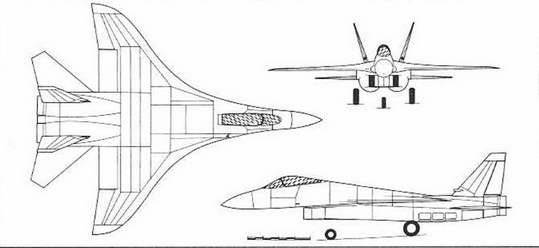
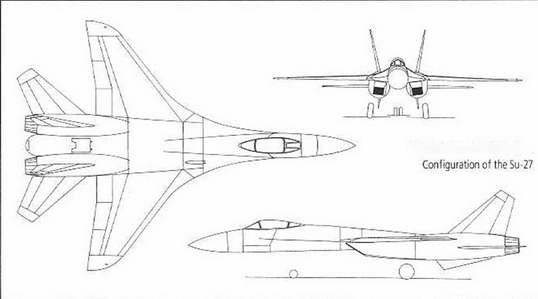
At the same time, another problem was solved - to enlist the support of the Air Force on the issue of switching to a single, unified for the fighter aviation of the Air Force and the country's air defense, the wavelength range for the radar. The same idea was made by the Mikoyan Design Bureau. The General Headquarters was engaged in the distribution of frequencies and ranges between the branches of the armed forces, and neither the Air Force, nor any of the companies individually could solve this issue. This is the only way, by the whole world, but we have led the General Staff to a decision-making justification report of several ministries. And it already entailed the development of new radars and a new generation of K-27 and K-27E air-to-air missiles.
As for the distribution of functions between the MiG-29 and Su-27 aircraft, the Su-27 TPFI was assigned the main role to the hostilities over the enemy’s territory: isolation of the front group, clearing the airspace (during the Second World War, this was called “free hunting”), using aircraft as a shock. For the MiG-29, the main task was to achieve superiority in the air over the battlefield and air cover of our front group, that is, the "umbrella" function. Such a distribution of tasks was based on a significant difference in flight range and maximum combat load: Su-27 - range 4000 km without refueling, weight of combat load 8000 kg; MiG-29 - range 1500 km, combat load weight 4000 kg. This meant that the Su-27 had a 1600 km combat range, that is, it could conduct air battles off the coast of the Atlantic Ocean, acting as an "air raider". This function is especially important for the ship fighter, which must be patrolling for an hour and a half at a distance of 400 km. The first flight copy of the aircraft had a wing with a pronounced aerodynamic twist and a fixed, highly bent down toe. The purpose of this arrangement was to achieve maximum flight range.
The T10-1 made the first flight in May of 1977, and a year later the second plane, T10-2, was connected to the flight tests. Both cars were equipped with engines AL-21FZ. The main purpose of the flight tests was to determine the flight characteristics and the testing of the electrical remote control system. Initially, there were failures of the channels of the computing control system, which the military tried to interpret as a prerequisite to flight incidents. It took a long time to explain that with a fourfold reservation, the prerequisite appears only after the third failure.
A serious defect was found in the hydraulic system of the aircraft. Since the working pressure in this system was 280 atm., The pipelines were made of high-strength steel VNS-2 to reduce the weight. A significant part of them were laid through the fuel tanks in order to cool the hydraulic fluid. And these pipelines began to burst. The reason was established quickly - insufficient purity (smoothness) of the surface of the bougie, pulled through the pipe, led to the formation of scratches on the inner surface of the pipe, which became stress concentrators. For us, every pipeline rupture stopped the plane for several days: it was necessary to remove the upper panels of the fuel tanks, replace the pipelines, close the tanks and test the fuel system for tightness. As a result, we were forced to replace the pipeline material with plastic stainless steel, that is, the savings in weight could not be realized.
7 July 1977. A misfortune occurred in the design bureau - the Honored Test Pilot, Hero of the Soviet Union, Colonel Yevgeny Soloviev died. At that time, V. Ilyushin and E. Soloviev flew the same program for the selection of gear ratios in the aircraft control system.
During the previous flight, V.Ilyushin discovered a slight swinging of the aircraft, which he verbally informed the leading engineer R. Yarmarkov: “I didn’t like the plane today. rocked, probably got into the chatter ". Unfortunately, this was not mentioned in the flight sheet. In the next flight, E. Solovyov got into a similar, but brutal buildup: three casts, one of which brought the plane to a destructive overload - the plane collapsed in the air.
At the funeral of E. Solovyov in the city of Zhukovsky, exactly at the moment when the coffin was carried out from the Palace of Culture, the Honored Test Pilot, Hero of the Soviet Union, Colonel Alexander Vasilyevich Fedotov flew over the MiG-23 flying area. The head of the LII, V. V. Utkin, sent curses after the plane and threatened with his fist. It really was a violation of all the rules of the flight service, A. Fedotov actually “stole” the plane from the parking lot and made an unauthorized departure, in order to pay the last debt to his good friend, at the same time with which he graduated from the school of test pilots. Not without consequences - many of the staff of the Institute were punished ...
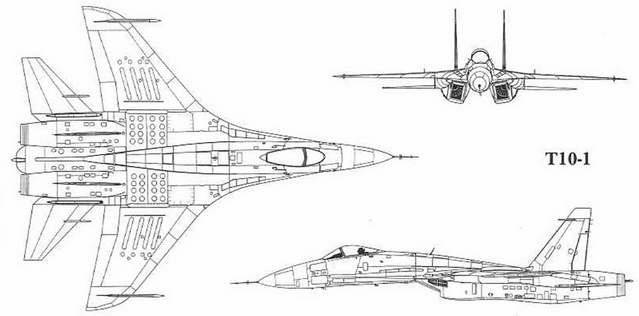
In 1976, M. P. Simonov was appointed Chief Designer of the Su-27 theme, and he bore the brunt of raking up the "garbage" that had accumulated in the process of finishing the aircraft. And by that moment we had increased from the side of subcontractors.
We received the first blow from OKB Saturn, which developed the AL-31F engine. The task for the engine recorded the requirement for the value of the minimum specific fuel consumption 0,61 + 0,02 kg of fuel per kg of thrust per hour - a very difficult amount to achieve. I met with General Designer Arkhip Mikhailovich Lyulka several times and persuaded him to agree. And persuaded.
Two years have passed. The cradle represents the draft design in which 0,61 has turned into 0,64 (that is, the specific consumption has increased by 5%). In addition, the requirements for maximum thrust near the ground and at height were not met. But in the end they will not be asked from the engine designer, but from the aircraft designer. For us, the "shortage" of the engine characteristics meant that the plane would not reach either the range or the speed of flight at altitude and on the ground. There was a big scandal. Minister V. Kazakov held a special meeting with us at the company, which was attended by A. Lyulka, the military and the heads of the institutes of the IAO.
Cossacks "metal lightning." He reached personal insults against A. Lyulka, promising to remove him from the academicians. Arkhip Mikhailovich bravely withstood the attack, then got up and very calmly, with a slight Ukrainian accent, said: “Vasil Aleksandrovich! You did not give me an academician, you did not take this title from me and take it away. You, Vasil Alexandrovich, should know this. And if you itch anyone to drive out, then expel this academician (and turned to Shalin, head of the All-Union Institute of Aviation Materials). He promised me a single-crystal blade for a turbine, which does not require air bleed to cool it. Where is the shoulder blade? No scapula! So I was forced to switch to a conventional steel cooled, that is, to select part of the working fluid for cooling. So much for the increase in unit costs, so much for the lack of traction. ”
But it so happened: the general designer of the aircraft is responsible for the work of all subcontractors. Not enough distance - add fuel, not enough thrust to obtain a given speed - reduce the drag of the aircraft. After all these turmoil with the engines, we were forced to subject the aircraft to a radical alteration. Reduced midsection, organized additional tanks for 800 kg of fuel, developed a new chassis scheme, the brake flap was transferred from the wing to the upper surface of the fuselage, and the keels from the engine nacelles to the newly organized horizontal tail beams. In order to reduce frontal resistance, the curvature of the wing was reduced and deflectable socks were introduced.
The fact that the new version of the aircraft quickly saw the light is the undoubted merit of Mikhail Petrovich Simonov, who showed exceptional energy in this matter.
The creation, to put it mildly, of a “greatly modified Su-27” was opposed by Minister V. Kazakov. And it could also be understood: the previous version of the series was already launched, huge costs were incurred (of the Su-27 planes in the first version were produced at the 9 production plant of copies). However, the energy of M. Simonov, with the support of Deputy Minister I. Silaev, did their job - the new version of the Su-27 received the right to life.
The second trouble was presented to us by the research and production association Phazotron, which developed the radar. They did not get a slot antenna. Again the meeting, the outcome of which was the decision to develop a radar with a conventional kosegrenovskoy antenna. The introduction of a radar antenna with a slot antenna was provided only from the Su-27M aircraft.
By the way, after all these meetings, Viktor Konstantinovich Grishin, General Designer of the Radar Station, was removed from work two months before he was awarded the title of Hero of Socialist Labor for developing the Zaslon radar for the MiG-31 interceptor.
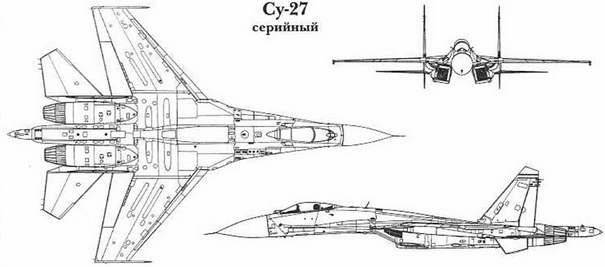
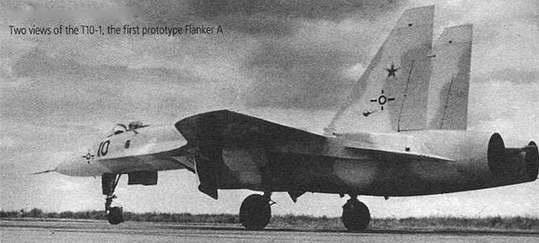
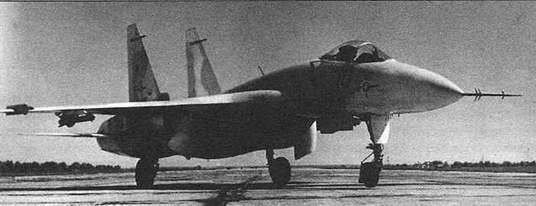
In December 1979, Mr. M. Simonov became Deputy Minister of Aviation Industry. The chief designer of the Su-27 was appointed deputy chief designer of our design bureau, former head of the control systems department, Artem Aleksandrovich Kolchin. In the spring of 1981, the tests of the first copy of the aircraft of the new layout - Т10-7 - began. The flights were successful, but in September of the same year the car died. In one of the sorties at the Belye Stolby ground, the plane was unexpectedly out of fuel for the pilot. Test pilot V. Ilyushin catapulted for the first time in his life. The cars that hit the design bureau did not correspond to the severity of the incident: Chief Designer A. Kolchin was removed from work, and lead engineer R. Yarmarkov was dismissed from the design bureau without the right to work at other aircraft manufacturing enterprises. I think that with P. Dementiev this could not be.
By this time I was uploaded to KB in other works that had no direct relation to the Su-27, therefore, to talk about stories the aircraft will no longer become. I believe that much has already been written about this magnificent car, both here and abroad.
Schemes L. Jurgenson and N. Gordyukova. Photo by L. Jurgenson and from the archive of the author.
commissioned by JSC "TRC Armed Forces" Zvezda "
Script writers: Andrey Kulyasov, Vladimir Petrov
Directed by: Andrei Kulyasov
Editing director: Andrey Kuljasov
Computer graphics: Alexander Pakhomtsev, Sergey Pernitsky
Music: De Wolfe
The text was read by the People’s Artist of Russia Alexander Klyukvin
Producer: Sergey Vikulin
Information